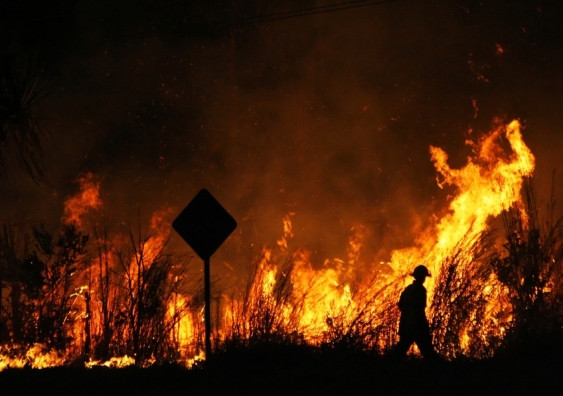Expert Guidance on Bushfire Management for Enhanced Fire Defense
In the world of bushfire monitoring, the relevance of expert recommendations can not be overemphasized. From understanding the nuances of bushfire habits to carrying out sensible actions such as firebreaks and defensible spaces, there exists a riches of expertise that can significantly boost fire defense initiatives.
Understanding Bushfire Behavior
To properly handle and alleviate the impact of bushfires, it is necessary to have a thorough understanding of bushfire habits. Bushfires are complicated natural phenomena influenced by various factors such as weather, topography, gas tons, and human tasks. Comprehending how these elements interact is crucial in predicting the actions of a bushfire, permitting for much better preparation and reaction methods.
One secret element of bushfire habits is fire spread. This encompasses the rate at which a fire developments, the instructions it takes, and the strength of the fires. By examining previous fire occurrences and analyzing fire patterns, professionals can expect how a bushfire might proceed under certain conditions. BMP. This understanding is crucial in designing discharge plans, allocating firefighting sources properly, and carrying out threat decrease procedures.
Moreover, comprehending ember attack, detecting, and fire whirls is essential in comprehending the full degree of bushfire behavior. By diving right into these complexities of bushfire behavior, authorities can enhance their readiness and response abilities, inevitably minimizing the impact of these devastating events.
Applying Firebreaks and Defensible Spaces
Comprehending bushfire habits is foundational for efficiently executing firebreaks and creating defensible spaces to enhance fire security. Maintaining these firebreaks via routine clearing of particles and plant life is crucial to guarantee their efficiency during a bushfire occasion.

Correctly executing firebreaks and defensible areas needs careful planning, regular maintenance, and neighborhood participation to make certain the highest degree of fire protection for residential properties and lives in bushfire-prone locations.
Using Early Caution Equipments
Releasing advanced early caution systems is crucial for prompt detection and alerting of possible bushfire dangers. By making use of sophisticated innovations such as satellite tracking, weather sensors, and thermal imaging, authorities can effectively monitor fire-prone locations and identify ignition resources at the earliest stages. These systems can supply real-time information on fire intensity, instructions, and behavior, allowing for timely decision-making and rapid deployment of firefighting resources to the influenced areas.
Very early warning systems additionally play an essential duty in notifying homeowners and areas about foreshadowing bushfire dangers. Through automated alarms, text informs, telephone call, and social media sites alerts, people can be promptly notified concerning emptying orders, safe sanctuary locations, and emergency situation procedures. This aggressive method not only conserves lives but additionally minimizes residential property damage by guaranteeing that people have sufficient time to leave and safeguard their homes.
Developing Evacuation Plans
Effective discharge strategies are necessary for ensuring the safety and security of locals in bushfire-prone locations. Establishing well-balanced emptying original site approaches is vital in alleviating the risks positioned by bushfires and securing human life. These strategies need to be comprehensive, taking into consideration various variables such as the topography of the area, the thickness of vegetation, and the most likely rate and direction of the fire's spread.
When producing discharge plans, it is necessary to establish clear evacuation routes and assembly points where resource homeowners can gather securely. These courses should be regularly maintained to ensure accessibility throughout emergencies. Additionally, interaction techniques should be in place to sharp residents of unavoidable risk and offer clear instructions on discharge procedures.
Collaboration in between local authorities, emergency situation services, and area members is necessary in establishing effective discharge strategies. Regular drills and workouts need to be conducted to acquaint locals with the treatments and guarantee a swift and arranged evacuation when a bushfire intimidates the area. By focusing on the growth of robust evacuation strategies, neighborhoods can enhance their strength to bushfire emergencies and lower the possible effect on lives and properties

Involving in Community Preparedness
In the realm of bushfire administration, promoting neighborhood readiness plays a pivotal duty in strengthening the strength of homeowners residing in risky locations. Taking part in area preparedness includes enlightening locals on bushfire threats, advertising fire safety and security practices, and establishing emergency plans collectively. By proactively including the neighborhood in preparedness initiatives, people become more educated and empowered to take aggressive steps to safeguard their lives and residential or commercial properties throughout bushfire events.
Community readiness initiatives usually consist of conducting fire drills, developing communication networks, and arranging training sessions ablaze suppression techniques. In addition, motivating collaboration amongst neighbors to develop a cohesive assistance system can dramatically improve the overall readiness degree of an area. When locals are knowledgeable and outfitted to respond look at this web-site efficiently to bushfires, the chance of minimizing damage and making certain safety boosts significantly.
Final Thought
In verdict, effective bushfire management needs an extensive understanding of fire habits, the application of firebreaks and defensible rooms, the utilization of early warning systems, the growth of evacuation plans, and area engagement in preparedness initiatives. By including these strategies, communities can enhance their fire security procedures and decrease the influence of bushfires on both building and lives. BAL Assessment. It is vital for all stakeholders to interact to create a more secure environment when faced with this natural disaster
To efficiently alleviate the impact and handle of bushfires, it is vital to have a comprehensive understanding of bushfire habits. By researching previous fire events and evaluating fire patterns, specialists can anticipate how a bushfire might proceed under details conditions.Understanding bushfire habits is foundational for properly applying firebreaks and creating defensible areas to boost fire defense. Engaging in neighborhood preparedness includes enlightening residents on bushfire dangers, advertising fire safety practices, and creating emergency strategies jointly.In final thought, efficient bushfire management needs a thorough understanding of fire behavior, the execution of firebreaks and defensible rooms, the utilization of very early warning systems, the development of evacuation strategies, and area interaction in readiness efforts.